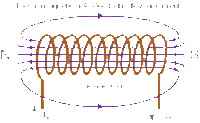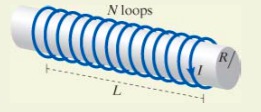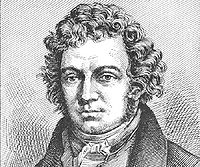Magnetic Field of a Solenoid: Difference between revisions
No edit summary |
|||
| (23 intermediate revisions by the same user not shown) | |||
| Line 5: | Line 5: | ||
==The Main Idea== | ==The Main Idea== | ||
[[File:Io15.gif|200px|thumb|right|alt text]] | |||
The purpose of this application is to explore another way to apply the Biot-Sarvart law. The magnetic field is uniform along the axis of the solenoid, when electric current is run through it. The solenoid has to have coils much larger than the radius. The length of the coil is much larger than the diameter, and its often wrapped around a metal rod. The rod produces a magnetic field when an electric current is passed through it. | |||
A solenoid is a type of electromagnet when it is used to create a controlled magnetic field or if it is used to resist a current changing, then it is an inductor. | |||
| Line 20: | Line 22: | ||
To determine the direction of the magnetic field: use your right hand and curl your fingers towards the direction of the current and the direction that your thumb is pointing to is the direction of the magnetic field. | To determine the direction of the magnetic field: use your right hand and curl your fingers towards the direction of the current and the direction that your thumb is pointing to is the direction of the magnetic field. | ||
===A Computational Model=== | ===A Computational Model=== | ||
A solenoid has a length of .5 meters and a radius of .03 meters and wound around 50 times a wire that has a current of 1 ampere. Find the magnetic field vectors. | |||
from visual import ∗ | |||
scene . width=1024 scene.x = scene.y = 0 | |||
scene . background = color . white | |||
L = 0.5 | |||
R = 0.03 | |||
kmag = 1e-7 | |||
I = 1 | |||
Nturns=50. ## number of turns in solenoid | |||
Nelts=20. ## number of line segments per turn | |||
bscale = 600. ## scale factor for B arrows | |||
.## make a solenoid | |||
dxx = L/(Nturns∗Nelts) | |||
xx = arange(L/2., L/2+dxx, dxx) | |||
omega = 2∗pi∗Nturns/L | |||
solenoid = curve(x=xx, y=R∗sin(xx∗omega), z=R∗cos(xx∗omega), color=(.9,.7,0),radius =0.001) | |||
.## make a list of zero lth arrows at observation locations | |||
Barrows =[] ## empty list | |||
dx = L/4. | |||
zz=0. | |||
for x in arange(-L/2, L/2+dx, dx): | |||
for y in [-.05,-.04, -.02,-.01,0,.01,.02,.03,.04,.05]: | |||
aa = arrow (pos = (x,y,zz), axis = (0,0,0), color = color.cyan, shaftwidth = .0003) | |||
Barrows.append(aa) | |||
for b in Barrows: | |||
for point in solenoid.pos: | |||
dl = point - dlstart | |||
r = b.pos - (dlstart +dl/2) | |||
b.axis = b.axis + (-bscale*kmag*I*cross(dl, norm(r)))/mag(r)**2 | |||
dlstart = point | |||
==Examples== | ==Examples== | ||
[[File: | ===Difficult=== | ||
To solve for the magnetic field of a solenoid, we need to do a three step process. | |||
Imagine a solenoid with a length L that is made up of N loops wound, each with a radius R and a current I. Each loop is one piece. | |||
[[File:Screen Shot 2015-12-05 at 6.12.26 PM.jpg]] | |||
Step 2: Write an Equation for the Magnetic Field Due to One Piece | |||
The origin of the solenoid is at its center. To find the location of one piece we have to find the integration variable, which is x, and then the distance from the loop to the observation location is d-z. There are also N/L loops in the solenoid so the number of loops in the length <math>\Delta x</math> is N/L*<math>\Delta E</math>. | |||
So this the equation we have so far using the magnetic field formula, shown as the top image on the right. | |||
[[File:FullSizeRenderRadz.jpg|200px|thumb|right|Equation]] | |||
Step 2: Add Up all the Pieces | |||
The net magnetic field lies along the axis and the sum is <math>\Delta B</math>. | |||
This can be turned into a integral from -L/2 to L/2, shown as the bottom image on the right. | |||
[[File:FullSizeRenderRads1.jpg|200px|thumb|right|The Integral]] | |||
The integral can be solved out using a standard table of integrals or an integration calculator. | |||
The | |||
==Connectedness== | ==Connectedness== | ||
There are many applications to solenoids that we use as a part of our everyday lives. They can be found in medical equipment, air conditioning devices, electric locking mechanisms, cars, and many others. To find out more about each of these applications in detail please go to [[Solenoid Applications]]. | |||
One example is the car starter solenoid. The starter solenoid receives a large electric current from the car battery and a small electric current from the ignition switch. When the switch is turned on, the small current forces the starter solenoid to close contacts and relays the large electric current to the starter motor. | |||
==History== | ==History== | ||
Andre-Marie Ampere originally coined the word "Solenoid" in the 1820's, which he used to describe a helical coil. He probably used solenoid while he was developing the theory for Ampere's Law, which can be used to find the magnetic field of a solenoid. | |||
[[File:Andre-marie-ampere-3.jpg|200px|thumb|right|Andre-Marie Ampere]] | |||
== See also == | == See also == | ||
[[Ampere's Law]] | [[Ampere's Law]] | ||
[[Right Hand Rule]] | [[Right-Hand Rule]] | ||
[[ | [[Solenoid Applications]] | ||
[[Magnetic Field of A Loop]] | |||
===Further reading=== | ===Further reading=== | ||
http://hyperphysics.phy-astr.gsu.edu/hbase/magnetic/solenoid.html | |||
===External links=== | ===External links=== | ||
http://www.gouldvalve.com/wp-content/uploads/2009/05/typical-uses-pages-1-3.pdf | |||
http://www.deltrol-controls.com/products/solenoids | |||
https://www.pa.msu.edu/courses/2000fall/PHY232/lectures/ampereslaw/solenoid.html | |||
==References== | ==References== | ||
http://hyperphysics.phy-astr.gsu.edu/hbase/magnetic/solenoid.html | |||
http://www.bachofen.ch/fr/schalttechnik/ProdukteF_Composants/Befehlsgeraete_Schalter_Mikroschalter/Johnson_Electric_LEDEX_Solenoids_EN_2014.pdf | |||
[[Category: | Matters and Interactions, 3rd Edition | ||
[[Category: Fields]] | |||
Latest revision as of 23:24, 5 December 2015
Created by ramin8 !!
A Solenoid is a type of electromagnet, which consists of a coil tightly wound into a helix. Usually it produces a uniform magnetic field when an electric current is run through it. The purpose of a solenoid is to create a controlled magnetic field.
The Main Idea

The purpose of this application is to explore another way to apply the Biot-Sarvart law. The magnetic field is uniform along the axis of the solenoid, when electric current is run through it. The solenoid has to have coils much larger than the radius. The length of the coil is much larger than the diameter, and its often wrapped around a metal rod. The rod produces a magnetic field when an electric current is passed through it.
A solenoid is a type of electromagnet when it is used to create a controlled magnetic field or if it is used to resist a current changing, then it is an inductor.
A Mathematical Model
This is the formula for the magnetic field inside a long solenoid: [math]\displaystyle{ B = {\mu _{0}} \frac{NI}{L} }[/math] This formula is used inside a long solenoid, when the radius of the solenoid is much smaller than the length. B is the magnetic field. [math]\displaystyle{ {\mu _{0}} }[/math] is a constant. N is the number of loops in the solenoid. L is the length of the solenoid.
To determine the direction of the magnetic field: use your right hand and curl your fingers towards the direction of the current and the direction that your thumb is pointing to is the direction of the magnetic field.
A Computational Model
A solenoid has a length of .5 meters and a radius of .03 meters and wound around 50 times a wire that has a current of 1 ampere. Find the magnetic field vectors.
from visual import ∗
scene . width=1024 scene.x = scene.y = 0
scene . background = color . white
L = 0.5
R = 0.03
kmag = 1e-7
I = 1
Nturns=50. ## number of turns in solenoid
Nelts=20. ## number of line segments per turn
bscale = 600. ## scale factor for B arrows
.## make a solenoid
dxx = L/(Nturns∗Nelts)
xx = arange(L/2., L/2+dxx, dxx)
omega = 2∗pi∗Nturns/L
solenoid = curve(x=xx, y=R∗sin(xx∗omega), z=R∗cos(xx∗omega), color=(.9,.7,0),radius =0.001)
.## make a list of zero lth arrows at observation locations
Barrows =[] ## empty list
dx = L/4.
zz=0.
for x in arange(-L/2, L/2+dx, dx):
for y in [-.05,-.04, -.02,-.01,0,.01,.02,.03,.04,.05]:
aa = arrow (pos = (x,y,zz), axis = (0,0,0), color = color.cyan, shaftwidth = .0003)
Barrows.append(aa)
for b in Barrows:
for point in solenoid.pos:
dl = point - dlstart
r = b.pos - (dlstart +dl/2)
b.axis = b.axis + (-bscale*kmag*I*cross(dl, norm(r)))/mag(r)**2
dlstart = point
Examples
Difficult
To solve for the magnetic field of a solenoid, we need to do a three step process.
Imagine a solenoid with a length L that is made up of N loops wound, each with a radius R and a current I. Each loop is one piece.

Step 2: Write an Equation for the Magnetic Field Due to One Piece
The origin of the solenoid is at its center. To find the location of one piece we have to find the integration variable, which is x, and then the distance from the loop to the observation location is d-z. There are also N/L loops in the solenoid so the number of loops in the length [math]\displaystyle{ \Delta x }[/math] is N/L*[math]\displaystyle{ \Delta E }[/math].
So this the equation we have so far using the magnetic field formula, shown as the top image on the right.

Step 2: Add Up all the Pieces
The net magnetic field lies along the axis and the sum is [math]\displaystyle{ \Delta B }[/math].
This can be turned into a integral from -L/2 to L/2, shown as the bottom image on the right.

The integral can be solved out using a standard table of integrals or an integration calculator.
Connectedness
There are many applications to solenoids that we use as a part of our everyday lives. They can be found in medical equipment, air conditioning devices, electric locking mechanisms, cars, and many others. To find out more about each of these applications in detail please go to Solenoid Applications. One example is the car starter solenoid. The starter solenoid receives a large electric current from the car battery and a small electric current from the ignition switch. When the switch is turned on, the small current forces the starter solenoid to close contacts and relays the large electric current to the starter motor.
History
Andre-Marie Ampere originally coined the word "Solenoid" in the 1820's, which he used to describe a helical coil. He probably used solenoid while he was developing the theory for Ampere's Law, which can be used to find the magnetic field of a solenoid.

See also
Further reading
http://hyperphysics.phy-astr.gsu.edu/hbase/magnetic/solenoid.html
External links
http://www.gouldvalve.com/wp-content/uploads/2009/05/typical-uses-pages-1-3.pdf http://www.deltrol-controls.com/products/solenoids https://www.pa.msu.edu/courses/2000fall/PHY232/lectures/ampereslaw/solenoid.html
References
http://hyperphysics.phy-astr.gsu.edu/hbase/magnetic/solenoid.html http://www.bachofen.ch/fr/schalttechnik/ProdukteF_Composants/Befehlsgeraete_Schalter_Mikroschalter/Johnson_Electric_LEDEX_Solenoids_EN_2014.pdf
Matters and Interactions, 3rd Edition